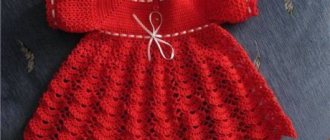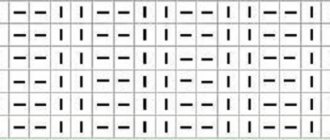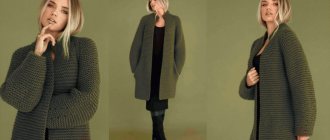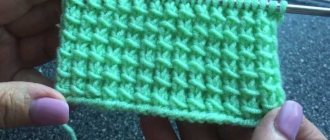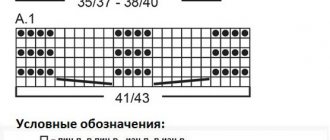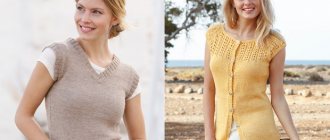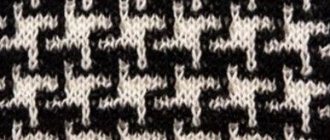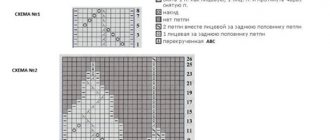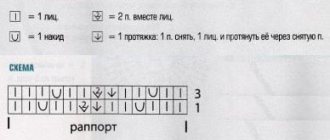How to knit an elastic band with knitting needles
The elastic band is knitted according to its own pattern, but the principle of execution is the same for all of them. The knit and purl loops alternate in a strictly defined order.
In many cases, this type of execution is given greater preference than others.
There are several reasons for this:
- the edges of any elastic band are smooth and do not curl along the length or width, which ensures neatness and aesthetics;
- a piece of clothing knitted in this way will “spring”, which prevents it from deforming when stretched.
As a result, vertical stripes are formed. Due to this, part of the product acquires the ability to stretch.
If you look at the diagrams, you will notice one feature. Already in the first row a knitted pattern is laid out. Each subsequent row is performed directly on this basis. That is, all knit stitches should be knitted with knit stitches, and purl stitches should, of course, be knitted with purl stitches. The tighter we knit, the denser the knitted parts will be.
See the options below in the article and after the article a catalog with pattern tiles.
This is a must see pictures for sketching for all ages, the best gifs for adults and children, beautiful coloring pages for every taste, stencils for cutting out paper.
Canadian gum.
Rubber bands from the book “The Big Book of Japanese Patterns” by Hitomi Shida. 260 unusual patterns for knitting"
More options on how to knit an elastic band with knitting needles.
A pattern that flows beautifully out of/into the rib *1 knit, 1 purl.*
Depending on where you insert the knitting needle, the pattern changes dramatically.
Below is option 1, on top is option 2. Separated with an elastic band *1 front, 1 back*.
Description, option 1.
We cast on an odd number of loops on the knitting needle.
1 row. Preparatory. Wrong side.
Edge, *1 knit, 1 purl*, 1 knit, edge.
2nd row. Edge, * 1 purl, from 1 loop we knit 3 as follows: insert the knitting needle behind the front loop, pull out the working thread, yarn over (thread away from you), 1 front from the front loop *, 1 purl, edge.
3rd row. Edge, *1 knit, 3 purl*, 1 knit, edge.
4 row. Edge, *1 purl, 3 knit*, 1 purl, edge.
5 row. Edge stitch, *knit 1, purl 3 together*, knit 1, edge stitch.
Repeat rows 2-5.
A lot depends on the yarn.
This is how the elastic band of the sock is knitted. Yarn 100% wool.
See how to knit socks on the website.
Description, option 2.
We cast on an odd number of loops on the knitting needle.
1 row. Preparatory. Wrong side.
Edge, *1 knit, 1 purl*, 1 knit, edge.
2nd row. Edge, *1 purl, from 1 loop we knit 3 as follows: insert the knitting needle into the front loop, pull out the working thread, yarn over (thread away from you), 1 front from the same front loop*, 1 purl, edge.
3rd row. Edge, *1 knit, 3 purl*, 1 knit, edge.
4 row. Edge, *1 purl, 3 knit*, 1 purl, edge.
5 row. Edge stitch, *knit 1, purl 3 together*, knit 1, edge stitch.
Repeat rows 2-5.
On the left is option 2, on the right is option 1.
False rubber band.
Rapport 4 loops +1 for symmetry and 1 row high.
*Knit 3, purl 1*, last knit 1.
We turn around and repeat the same row.
Almost all hats start with an elastic band. Some are knitted entirely with rib. These include:
Knitted TakOri hat. Description, diagram, video.
Knitted pumpkin hat. Description, video MK.
Knitted ribbed hat. Diagram and description.
Did you get the answer to the question of how to knit an elastic band with knitting needles? Do you have any questions or suggestions? Write to us here:
Elastic band with tourniquet
- 1st, 3rd, 5th, 13th, 15th and 17th rows: P1, * K1, P2. *, repeat from * to *, purl 1;
- 2nd and all even rows: how the loops look, i.e. knit stitches are knitted above the knit stitches, purl loops are knitted above the knit stitches, and a purl loop is knitted above the yarn over.
- 7th row: 1 p. p., * 1 p. p., 2 knit. p. change places with 1 purl. to the left, working thread behind the work, knitting 1 p. p., 2 p. knits., 1 p. p. swap places with 2. knits. st to the right, working thread behind the work, knitting 2 sts, purl 1, purl 1*, repeat from * to *, purl 1;
- 9th row: 1 p. purl., * 1 p. purl., change 2 sts. for 2 p. persons. to the right, knitting all the loops of the faces., 1 st. *, repeat from * to *, purl 1;
- 11th row: 1 p. p., * 1 p. p., 2 knit. p. change places with 1 purl. to the right, working thread behind the work, knitting 1 p. p., 2 p. knits., 1 p. p. swap places with 2. knits. st to the left, working thread behind the work, knitting 2 sts, purl 1, purl 1*, repeat from * to *, purl 1;
French gum
This simple pattern requires an odd number of stitches.
First row: knit the first loop, then repeat in the order of 2 purl, 2 knit stitches. The row ends with two knit stitches.
Second row: knit 1 and repeat purl two, knit two.
Due to the fact that the row is shifted, the pattern looks textured.
Elastic band with stripes
For this elastic band, all rows, knit and purl, are knitted the same way.
1st and all subsequent rows: * 2 stitches purl, 1 yarn over, 2 stitches together to the right (you can go to the left, but then everywhere) *, repeat from * to *.
Elastic band in plaits
1st row: * Slip 1 st, knit 1 *, repeat from * to *;
2nd, 4th, 6th, 8th and 10th rows: * Knit 2 stitches together. crossed, remove 1 st with yarn over, purl*, repeat from * to *;
3rd, 5th, 7th and 9th rows: * Slip 1 stitch with yarn over, knit 2 stitches together. crossed *, repeat from * to *;
11th row:* Slip 1 p. with yarn over, knit 2 p., slip 1 p. with crochet, purl, 2 p. knit together, knit 1 p.,( Knit 2 stitches together, remove the loop together with the yarn over onto an auxiliary needle before work, transfer the next stitch to another auxiliary needle for work, knit the next loop together with the yarn over, remove the loop from the 2nd auxiliary needle together with the yarn over, as a purl, knit a loop from the 1st auxiliary needle together with a yarn over), slip 1 st with a purl yarnover, knit 2 stitches together, slip 1 st with a purl double crochet, knit 2 stitches together. *, repeat from * to *.
Knit once from 1st to 11th, then repeat from 2nd to 11th.
Using fine yarn
What to do if you want to try it, but you only have thin yarn at home? What if the method doesn’t work and the thick yarn will be bought in vain? Or maybe you like the effect of a fluffy elastic band made from fine yarn? Then the next method is just for you. It is worth considering that when creating a “lush” effect, the yarn consumption will double.
Related article: Elephant made from towels using origami technique
You can try patent elastic from thin yarn on any number of stitches, casting them on together with the edge stitches.
The first row begins with an edge loop. Next, we alternate one knit stitch with one purl stitch, ending with an edge stitch. The second row also begins and ends with edge loops. Purl stitches are knitted purlwise. The highlight of the method is knitting knit stitches: insert the right knitting needle into the loop on the previous row and knit it with a knit stitch, removing the loop from the left knitting needle. Subsequent rows are knitted similarly to the second.
A training video will help you understand the method better:
A lush elastic band knitted with your own hands is a guarantee of pleasure from both the process of creating the product and the process of wearing it. Soft, fluffy items will become your favorite in your wardrobe, especially during the cold season. The main thing is to choose the right yarn and choose the most convenient knitting method for yourself. Then creating a masterpiece will not require much time and experience.
Yin Yang
1st, 3rd, 5th, 19th, 21st and 23rd rows: , * 2 p. p., 2 p. knit. *, repeat from * to *;
2nd and all even rows: how the loops look, i.e. knit stitches are knitted above the knit stitches, purl loops are knitted above the knit stitches, and a purl loop is knitted above the yarn over.
7th row: 1 p. purl., * 1 st. .persons *, repeat from * to *, purl 1;
9th row: 1 p. purl., * change 4 p. 2 to 2 to the right, 2 p. together to the right, 1 yarn over, 2 p. purl., 1 yarn over, 2 p. together to the left, change 4 p. 2 2 to the left, 1 p. purl. *, repeat from * to *, purl 1;
11th row: 1 st. purl., * 1 st. purl., 2 sts. 1 yarn over, 2 p. purl., 2 p. st., 1 p. purl, *, repeat from * to *, 1 p. purl.;
13th row: 1 p. p. , 2 p. purl., 2 p. knit., 1 p. purl. *, repeat from * to *, purl 1;
15th row: 1 st, purl 8, 1 st, change 4 loops 2 by 2 to the left, 1 yarn over, 2 stitches together to the right, 2 stitches purl, 2 stitches together to the left. 1 yarn over, change 4 loops 2 to 2 to the right, 1 p. purl., *, repeat from * to *, 1 p. purl.;
17th row: 1 st. purl., * 1 st. purl., 2 sts. knit., change 4 sts. 2 to 2 left, 2 sts. persons, 1 p. *, repeat from * to *, 1 p.
Irregular zig zag
1st and 2nd rows: * 2 stitches purl, 1 yarn over, 2 stitches together to the left *, repeat from * to *
3rd and 4th rows: * 2 stitches together to the right, 1 yarn over, 2 stitches purl. * repeat from * to *;
How to knit corn rib with knitting needles
It’s not for nothing that this gum is called corn; in its finished form it looks like an ear of corn interspersed with small corn grains. It looks unusual and stylish.
What is it suitable for?
For knitting hats, for knitting scarves
How to knit
Cast on 19 loops
We knit the first row like this - 3 knit loops, then we make a yarn over and remove the loop and again 3 knit loops, then we make a yarn over and remove the loop, and so on until the end of the row.
Second row - remove 1 edge loop and then knit, one knit loop on top, then 2 together, yarn over and knit loop that was removed from above and another knit loop on top and then yarn over and remove the loop and then repeat again 1 knit loop on top, 2 together knit on top, knit one more stitch on top, yarn over and slip off the loop and do this until the end of the row. At the end of the row, knit from above and end the row with a purl stitch. To ensure that the edge of the item is even
Unfold the knitting to the front side.
1 row. Remove the edge stitch, knit stitch on top, knit 2 stitches together, knit one on top and yarn over and trail. Let's retake the loop.
And again knit stitch on top, knit 2 together on top, knit one on top and yarn over and re-knit and knit until the end of the row
That's it, the corn gum is ready. It looks the same on both sides.
To calculate the loops, select the number of loops that are a multiple of 4, + 1 additional. loop, + 2 edge loops.
Video of the pattern
Description of knitting a fluffy elastic band
The fluffy elastic band is classified as “Patent”. Their main characteristic is their double-sidedness. Any of them looks the same from both the front and back sides. You can verify this by watching the video master class.
Patent patterns come in two types. The first is knitted with removed loops, the second with loops raised from the bottom row. “Lush gum” belongs to the second variety. Patent patterns are knitted tightly because the fabric is extremely elastic. First, a sample is made, which is washed and dried. Only then can you determine the density of the fabric, because it often stretches after washing. To knit a pattern, we cast on an even number of loops. In the first row after the edge we alternate 1 IP and 1 LP. In the second, we also remove the first edge, then knit 1 IP, and 1 LP from the loop of the bottom row:
Read
Master class on knitting comfortable but fun booties for boys
We knit rapport to the end, and perform the following rows in the same way:
The attached photos show how fluffy and voluminous the patent elastic is.
How to knit English faceted rib with knitting needles
This pattern is the most popular and famous all over the world. It is loved for its simplicity and speed. Things knitted with this type are dense, elastic, and hold their shape.
What is it suitable for?
For knitting hats, for knitting scarves, berets, sweaters. This option is suitable for both children's and adult models.
How to knit:
This elastic band is knitted, unlike a simple English elastic band, not like 1 row, one knit one, one purl, but this type is knitted two knits, two purls, i.e. it is knitted like the base of a 2 by 2 elastic
So let's begin. We cast on the knitting needles 18 loops
First row. Knits like a two by two elastic band. Let me remind you how to knit: knit 2, purl 2.
Second row and last row. Knit as follows. Remove the first edge loop.
We knit knit stitches from the bottom row. - 2 times. Then purl as usual.
Then again knit as knit from the bottom row. - 2 times.
Video of the pattern
Colored corrugated elastic band
Knitting pattern and description
The so-called lush corrugated elastic is a type of lush. Scarves are often knitted with it, as it is colored and double-sided. The back side of the relief is different from the front side, but they both look great.
Handicrafts are performed exclusively with circular knitting needles. The thing is that they are necessary due to a special knitting technique. The peculiarity of needlework is that it contains such Ps, where the work moves to the second end of the knitting needle, but does not turn. In addition, the edge loops are knitted in accordance with the pattern.
- In accordance with the conventions, an empty square indicates the LP in the front row, and the PI in the back row.
- A square with a circle inside is IP in the front row, and LP in the purl row.
- A square with an arrow is an LP from the lower P on the front side, or an PI from the lower P on the wrong side.
- A square with an arrow and a circle means IP from the lower P on the front side, and LP from the lower P on the wrong side.
- Horizontal arrows indicate the direction of knitting.
Here the initial, second and fourth R are knitted with threads of the same color, and the first and third are made with the second shade of thread.
